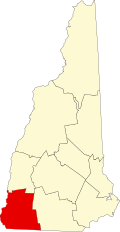New Hampshire Conservatory of Music and the Arts | |
 | |
| Location | Central Sq., Winchester, New Hampshire |
|---|---|
| Coordinates | 42°46′24″N72°22′59″W / 42.77333°N 72.38306°W |
| Area | 0.7 acres (0.28 ha) |
| Built | 1912 |
| Architect | St. Clair, S. Winthrop |
| Architectural style | Colonial Revival |
| NRHP reference No. | 80000276 [1] |
| Added to NRHP | May 15, 1980 |
The Winchester Memorial Church, also known as the New Hampshire Conservatory of Music and the Arts, is a historic civic building in the center of Winchester, New Hampshire, United States. Built in 1912, it is a prominent local example of Colonial Revival architecture. It replaced a meeting house that was the location of the Winchester Profession, a key development in the history of Unitarian Universalism. The building was listed on the National Register of Historic Places in 1980. [1] It was acquired in 2006 by the Universalist Heritage Foundation as a memorial to the site's role in Universalist history.


